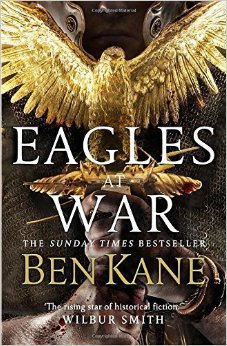Eagles At War

Ben Kane thunders back into the charts with what I can only describe as an epic novel of the Teutoburg disaster. I’m a fan of Ben’s work, though since I read it his first Hannibal book has remained my favourite. Until this one.
I’m sure there are folks out there who don’t know the history Varus’ disastrous campaign in Germany in 9AD, of Arminius and the tribes. Of the Teutoburg massacre. A lot of you will, even those not particularly au fait with Roman history. It is the most ignominious military loss in Roman history and infamous as such. It ranks up there with Crassus’s death at Carrhae or the unpleasant fate of Valerian, the only emperor ever captured by the enemy. I shall spare you the details. Suffice it to say that this is a novel about Rome and the German tribes in their early days, when there was potential for a settled, Romanised Germany that would become truly part of the Empire. It was a fragile time, but a hopeful one for Rome, and for some of the natives. But not all the Germans were ready to bow their head to the emperor. Cue one man with an ambitious plan to unite tribes whose mutual hatreds went back centuries based purely on the belief that they hated Rome more even than they hated each other. As governor Varus plans his summer marches into the east, so Arminius, the son of a chieftain and a man trained by decades of Roman service, begins to put his plan into action.
Enough about the plot. No spoilers (though to be honest a glance at any webpage or book that mentions Varus or Arminius will immediately barrage you with spoilers if you are in the dark. No matter. This book is not written hinged on complete innocence on the part of the reader. As a man who knows the events around which it is based, I can say with certainty that knowledge of the Varian disaster does not ruin the book, so don’t worry about that.
The book is divided into two parts, with the first being the events that form the backdrop to the rebellion, introducing us in detail to the characters, locations, motivations and themes. The second part is the part that most of you will be waiting for. It surprised me to find how much of the book Ben had devoted to the lead-up, when I had assumed the disaster itself would provide enough material for a book on its own, and possibly even more than one book. But d’you know what? It worked. The way Ben has built the plot gives it so much more of a human edge and a personal feel that it would have missed had it concentrated more on the battle itself at the expense of what precedes it. It also means that the book starts slowly, peacefully and pleasantly, and gradually builds pace throughout the first half, with tension rising, and then gallops into the second part in a crescendo that just peaks time and again right to the end of the book.
What I think deserves first special mention here is Ben’s characters. Not for their realism or depth. If you’ve read Ben’s books before then you expect nothing less than deep and realistic characters. No, what I like is who Ben has chosen to tell his story. We have Varus, the governor, a senatorial noble of Rome. We have Arminius, the German chieftain serving in Rome’s military. Yes, they are the prime movers in the events behind the book. But in order to give us the events from an intimate level, we also have a veteran centurion – Tullus – and a young legionary recruit – Piso. Thus every level is open to the reader, from those who shape the empire to those who die for it. Writing a tale like this from four such disparate viewpoints cannot be easy, but it is carried out with skill, and the reader can identify with and follow each of the four. Also, each is sympathetic in their own way – even Arminius! Oh, there is one loathsome character in there, but I’ll let you find him on your own. In fact, Varus is here given a very favourable treatment, flying in the face of the more common portrayal of an impetuous fool. Refreshing. And because of the way the story is written, there is no sense of ‘good guy and bad guy’ in Eagles at War. As is so often the case in reality, both sides are simply people, each with their own belief in the value of their motives.
In terms of themes, the book gives us a nice view of what it might have been like in the early stages of the Romanisation of a land, with tribal leaders both obsequious and resistant, some trying to outdo each other in the new regime while others grumble about taxes. It also makes some use of an aspect of the Roman military that is very rarely mentioned in novels: the slaves. When an author deals with the five thousand men of a legion, plus the cavalry and support etc, what is often forgotten is that most officers would have at least one slave, and the senior ones probably and entire household of them. Think on the activity of slaves in a Roman camp, serving one legate, one camp prefect, six tribunes and sixty centurions, plus various other officers. We are not talking about the odd body, after all. The human aspect is handled well particularly through the trials and tribulations of young Piso, and of a woman with her girl and pup, who become a recurring thread. And as for the sheer power of the loss of a legion’s eagle? Well that is put over very well. The chaos of unsought and unexpected combat is a major theme in the second part of the book and drives the narrative at least as much as the specifics of the timeline.
In fact, part two reminded me in style at times of two different tales. It carries the epic scale of The Longest Day, roving back and forth across the locations, giving us a view of events from several angles without dropping the pace of the action. And it also contains all the tension and eeriness of a nervous journey, a-la Apocalypse Now (or Heart of Darkness, of course). The legions are strung out, there is trouble communicating, there are isolated pockets of men involved in their own tiny wars all forming part of one great whole.
All in all, this is a masterpiece of the genre, from the earliest stages of the troubles right up to the tense, violent climax. In fact, twice in this read I was so hooked that I continued reading at night long after I was really ready for sleep. Roll on the next book, I say, for I think I know what it will involve….


Am reblogging…I bow to the master… 🙂
LikeLiked by 1 person
tigers68
July 2, 2015 at 11:46 am
Reblogged this on Historical Fiction reviews and commented:
Another excellent review by SJA Turney
LikeLiked by 1 person
tigers68
July 2, 2015 at 11:48 am
[…] Again, Ben Kane moves into a new milieu, having dealt with the Caesarian era, Hannibal and Spartacus. And this time he’s moved more into my period of choice. To take on the Teutoborg disaster and try to cover the scope in a single novel is a massive undertaking and he did it justice from both sides of the conflict, which was nice to see. Read my review here. […]
LikeLike
Top 10 reads of 2015 | S.J.A.Turney's Books & More
December 31, 2015 at 12:53 pm
I will now be rwading his “Hannibal” book/s!
Loved ‘Eagles at War’ series.
Thanks for all ypur AWESOME reviews!!
Keep ’em coming!
LikeLike
Suzi Graham
April 1, 2021 at 1:48 pm